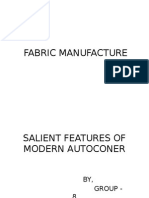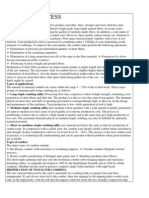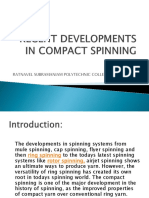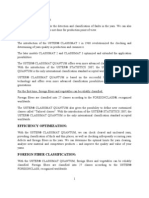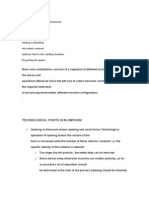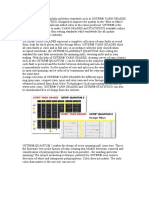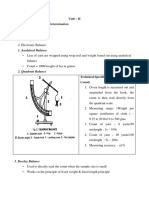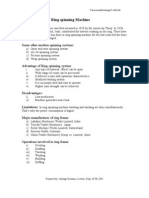Simplex Machine / Speed Frame/ Flyer Frame/ Roving Frame
Uploaded by
Abhi KothariSimplex Machine / Speed Frame/ Flyer Frame/ Roving Frame
Uploaded by
Abhi Kotharitextilelearner.blogspot.
in
http://textilelearner.blogspot.in/2012/01/simplex-machine-speed-frame-flyer-frame.html
Simplex Machine / Speed Frame/ Flyer Frame/ Roving Frame
Experiment name: Study on material passage and general description of speed frame/ Flyer frame/ Roving
frame/ Simplex m/c.
Objectives:
1. To draft the sliver to reduce weight per unit
length.
2. To insert small amount of twist to strengthen the
roving to prevent breakage during next
processing.
3. To make conical or tapper shape of the bobbin.
4. To wind twisted strand on the bobbin.
M/c specification:
Simplex Machine
Platts
The United Kingdom.
Main parts:
1. Separators
2. Guide rollers
3. Drafting rollers
4. Dead weight
5. Flyers
6. Spindles
7. Motor
M/c description: Draw frame slivers are fed to the roving frame in large cans. The slivers are passed through
separators and then over the guide rollers and tension rollers. Now the slivers are passed through the drafting
rollers. There is dead weight over these drafting rollers. Here generally 6-15 draft is given. The delivered slivers
are too thin to hold themselves together and so twist is needed. The drafted strands of fibres are then passed
through flyers. These flyers create twist in the fibre strands by rotating and twist is usually 30-65 per meters.
There are spindles in the flyers on which the twisted fibres i.e. roving are wound.
Required data:
1. Pitch of spindle = 7.5 inches
2. No. of flyers = 40
3. Bobbinn length = 11.5 inches
4. Lift of bobbin = 10.3 inches
5. Outer diameter of bobbin = 1.75 inches
6. Inner diameter of bobbin = 1.3 inches
Conclusion: The passage of material through the simplex m/c is easy. During this passage, three works are
done on the sliver: drafting, twisting and winding. The output of
this machine is roving which is then fed into the Ringframe.
Ringframe is the last m/c of yarn spinning and after that m/c,
we get yarn.
Fig: Passage diagram of Simplex
You might also like
- LK 69 U %guidelines For Optimizing Sliver U% in Comber LK69No ratings yetLK 69 U %guidelines For Optimizing Sliver U% in Comber LK699 pages
- SSM College of Engineering, KOMARAPALAYAM - 638 183.: Laboratory ManualNo ratings yetSSM College of Engineering, KOMARAPALAYAM - 638 183.: Laboratory Manual65 pages
- Recent Developments in Compact SpinningNo ratings yetRecent Developments in Compact Spinning17 pages
- 1.all Drafting System. All Parts of Drafting0% (1)1.all Drafting System. All Parts of Drafting3 pages
- Calculation of Twist On Roving Frame and Ring Spinning Frame by Drawing Twist Gearing Sketches of The Machines.100% (1)Calculation of Twist On Roving Frame and Ring Spinning Frame by Drawing Twist Gearing Sketches of The Machines.5 pages
- Fundamentals of Textile Machines and ProcessesNo ratings yetFundamentals of Textile Machines and Processes75 pages
- Uster Technologies Regularly Publishes Standards Such As USTERNo ratings yetUster Technologies Regularly Publishes Standards Such As USTER12 pages
- Textile Technology:: "Spinning": Rings and TravellersNo ratings yetTextile Technology:: "Spinning": Rings and Travellers10 pages
- Blow Room Carding Draw Frame TX Comm. 35 Pges PDF100% (1)Blow Room Carding Draw Frame TX Comm. 35 Pges PDF35 pages
- Development in Sizing Machine: By: Tanveer Malik, P.K.Roy & H.K.SinghNo ratings yetDevelopment in Sizing Machine: By: Tanveer Malik, P.K.Roy & H.K.Singh24 pages
- Simplexenhanced 150401131931 Conversion Gate01No ratings yetSimplexenhanced 150401131931 Conversion Gate0146 pages
- Launching The BMW Z3 Roadster: Abhi Kothari 150103006 Section C0% (1)Launching The BMW Z3 Roadster: Abhi Kothari 150103006 Section C8 pages
- Company Financial Statements Income StatementNo ratings yetCompany Financial Statements Income Statement2 pages










